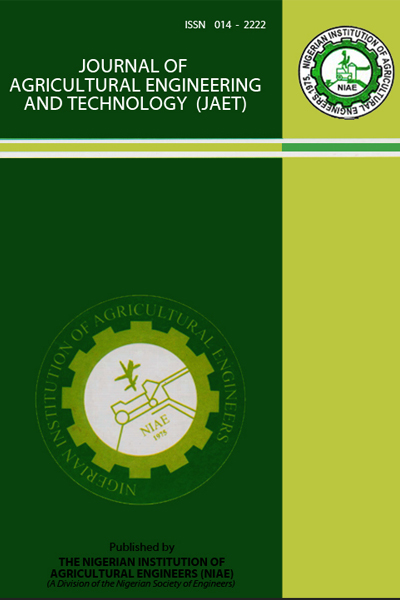DRYING KINETICS OF IBADAN-LOCAL TOMATO
Keywords:
Tomato, models, effective diffusion coefficient, pre-treatment, activation energyAbstract
There are several tomato cultivars grown in Nigeria, but their production is seasonal and availability
geographical in spite of their importance in the daily dietary intake. They are usually in short supply in
the dry season and effective storage in the fresh state still poses a challenge. Among these available
cultivars in the southwestern Nigeria is Ibadan-Local (Lycopersicum esculentum CV), a variety with
higher fruit yield and longer fruiting tendency which has received little or no significant attention because
of the higher preference of other cultivars to it. Pre-treatment methods have been reported to improve
drying characteristics of fruits and vegetables generally but there is dearth of information on drying of
Ibadan-Local variety of tomato despite its high nutritional value.
Sixteen grams (16g) of Ibadan-Local variety was sorted for complete ripeness, firm and void of
injury/bruises and osmotically pre-treated in a binary osmotic solution containing 45g of sugar and 15g of
salt and a solution temperature of 50oC previously prepared to have a solution to fruit ratio of 10:1 and the
experiment was conducted in triplicate. Osmosized samples were removed, drained and the surface
mopped up to eliminate posterior weight at 30 minutes interval and weighed electronically until a
constant weight was attained (Water loss at infinity). These osmotically pre-treated and fresh samples
were then subjected to drying at 40, 45 and 50oC in an oven that was previously run on a no-load mode
for 30minutes. Mechanism of mass transfer phenomena was thus studied. Five thin layer drying models
(Exponential, Henderson and Pabis, Page, Modified Page and Logarithmic) were compared and fitted into
the experimental moisture ratio. Adequacy of fit was based on highest R2, χ2 and least RMSE. Effective
coefficient of moisture diffusivity and Activation energy were determined using Arrhenius equation.
Results of water loss and solid gains were significant (p<0.05) for all variables considered. Different
models fit at different temperatures. The Exponential model fitted at 40 &45oC with R2 value range of
0.8291-0.8981 and 0.9352-0.981 for treated, 0.9453-0.9829 and 0.8281-0.9224 for untreated tomato
having the best fit in Page and Modified Page and RMSE value range of 0.07966-0.10089,0.0464-0.364
(treated) and 0.0301-0.0538(untreated). At 500C, R 2 value ranged between 0.8461-0.8981 (treated) and
0.8281-0.9224 (untreated), with RMSE value of 0.07984-0.09659 and 0.0778-0.1008. Calculated values
of effective moisture diffusivity varied from 1.17-3.51x10-8 and 1.25-3.13x10-8 and activation energy
varied from a maximum of 52.61-46.81 KJ/mol in treated and untreated tomato. The present study has
shown that the proposed empirical models were able to describe mass transfer process during osmotic
dehydration of tomato as the values calculated using the proposed empirical models were in good
agreement with the experimental data.


